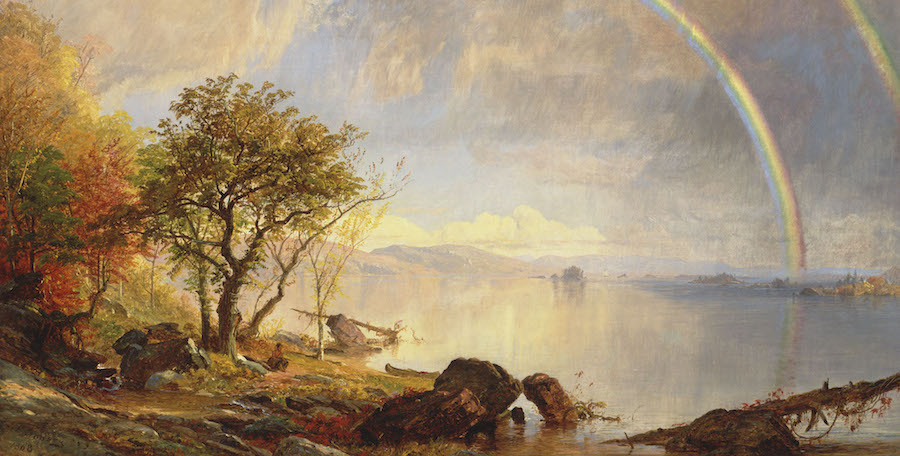David McGrogan recently requests:
People may already have done this, but providing DMs with handy, accessible and beautiful three-line descriptors of what the players can see as they traverse one hex or another, or go from one point to another on a pointcrawl, would I think be a very useful addition to wilderness campaigning.
Without overdoing things, my suggestion for improvising these in play or writing would be: when breaking new ground, describe three aspects of background (down, sides, up), one of atmosphere (around), and add in "figures" where appropriate.
 |
| A 19th century Transcendentalist landscape by Jasper Francis Cropsey |
The narrative should tell you what you see and hear from below (the ground on which you walk), to the side (the sightline or blockage of the vista), and above (the condition of the sky). The atmosphere covers the motion, feeling, and scent of the air immediately around you. Figures, then, are any specific landmarks, ships, throngs, or creatures that may be glimpsed among these backing elements, and it's wise to use them sparingly and only double up on special occasions.
One or two things from each of these lists with appropriate detail and maybe a bit of prose imagery should give a rich and narratable description to go on for any given stretch of travel. Then, part of the art is narrating change in the conditions when the terrain or weather themselves change.
Below. Is the ground ...? rising, falling, or level; flat, rolling, uneven, humped, jagged; solid, treacherous, shaky, slippery; muddy (deep, sticky, malodorous, water-washed); earthy (red clay, black loam, dry earth, silt); sandy (packed, drifting, red, pale); rocky (pebbles, shingle, boulders, fissures; slate, chalk, limestone, granite, volcanic); snowy (thin, drifting, deep, ice-crusted, melting); grassy (dry. lush, tall, grazed-down, sparse, weedy); brushy (thorns, berries, holly, chaparral); forest floor (dry leaves, dry needles, moist mulch, ivy). Is the path straight, curving, meandering, winding? If on water, is it salt or fresh, clear or clouded, fast or sluggish, smooth, wavy, or turbulent, strangely dead or teeming with plant and insect life?
To the sides. Is the view clear and unobstructed? On a curved Earth, the horizon stands at 5 km (3 miles) at ground level, but climbing just 300 meters (1000 feet) lets you see ten times that. If anything obstructs your view, what is it? Hills, cliffs, mountains, canyon walls, tall trees, fog, haze, dust. If nothing is in the way, what do you see?
Above. How much light in the sky - sun, moon, stars? How many clouds, what shape, how do they filter or reflect the light? Is it sunrise, sunset, high noon, dusk, night? If the sky is visible, is it clear or hazy? Does the moon show at day? Are there birds, sun dogs, a rainbow?
Atmosphere. Is the temperature bone-freezing cold, breath-clouding cold, chilly, warm, hot, dangerously hot? Is the air crisp, humid, misty, thin, oppressive? Is the air moving, is the wind steady or fitful, the direction constant or changeable? Are there mineral smells - sulfur, mineral oil, chalk dust - or vegetable smells - pine needles, moldering leaves, wild flowers, tree pollen - or, rarely, the scent of a passing animal, a corpse or some dung? Are there intangibles that can be summed up in a word - brilliant, harsh, eerie, serene?
A couple of examples that might have been applied in my current campaign, with an example "figure" in red:
1. The party, on horseback, is proceeding through a valley in an area of scrub and wooded hills, then mounting the end of the valley and descending to where there's a river and a ferry. It's late October.
"Dry fallen leaves and needles crunch under the horses' hooves as you make your way through the valley. The trail winds through low bushes, holly and others with a few quivering leaves in the wind, and to either side the ground rises, pine trees and yellow-leaved birches on the slopes and heights. The sky is deep blue and crisp with a few scudding clouds high up. A chilly wind blows from the west and sets the fallen leaves to dancing and flying with a dusty, papery scent."
2. The party, on a commercial boat, is traveling up-river between the wooded hills and a less covered highland, toward a town near a mountain lake. The season is similar, but the weather is still and overcast.
"The river is dotted with fallen leaves, yellow and brown against the dark water. The oarsmen move confidently against the weak and sluggish current with heaving, steady strokes. To your right, the rising land is masked by pine trees that emerge from a curtain of river willows with strings of sparse yellowing leaves. To your left, the hills are bare, sheer faces of dark granite with grassy shelves. The clouds above are stony and gray, at times letting distant shafts of light down into the still, ominous air. In the gaps ahead, when the river runs straight, rise the black snow-capped peaks of a tall mountain range."
No great poetic imagination is needed to follow this template more or less freely. Like all narrative devices it has to be applied with tact and moderation -- you don't need to lavish such description when going over the same ground a second time, for instance. However, much like the procedure of considering all five senses when describing a dungeon room, I think this down- sides - up - around procedure has good potentional to add weight and color to your outdoor description.




















